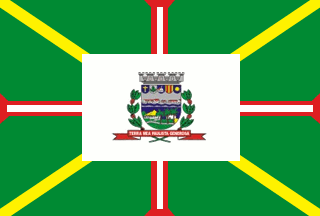 image by Dirk Schönberger,
8 December 2012
image by Dirk Schönberger,
8 December 2012Based on: http://www.mococa.sp.gov.br/acidade.php?informacoes=Brasão%20e%20Bandeira

Last modified: 2012-12-29 by ian macdonald
Keywords: sao paulo | mococa |
Links: FOTW homepage |
search |
disclaimer and copyright |
write us |
mirrors
 image by Dirk Schönberger,
8 December 2012
image by Dirk Schönberger,
8 December 2012
Based on:
http://www.mococa.sp.gov.br/acidade.php?informacoes=Brasão%20e%20Bandeira
A green flag bearing a narrow yellow saltire, and a narrow red-edged, white upright cross pattée, with the municipal arms in the centre on a white rectangle.
Official website at
http://www.mococa.sp.gov.br
Dirk Schönberger,
8 December 2012
The flag is green, divided in eight quarters by a thin yellow saltire and a thin Cross of the Order of Christ. In the middle of the flag is placed a white rectangle charged with the municipal coat of arms.
Photos of the flag
http://www.panoramio.com/photo/17234931
http://www.mococa.sp.gov.br/departamentos/antigo/etc_arquivos/saudeanexos/saude_10.12.2010.gif
http://www.mococa.sp.gov.br/departamentos/publicacoes/20120926151000%20(2).jpg
http://www.mococa.sp.gov.br/departamentos/publicacoes/20121019161100.jpg
http://www.mococa.sp.gov.br/departamentos/publicacoes/20120518162400%20(1).jpg
http://www.mococa.sp.gov.br/tvprefeitura.php
[Here the Cross of the Order of Christ appears to have a broader red border, which makes it more easily recognizable. This is, however, a detail of minor significance, if any.]
The coat of arms was designed by Afonso d'Escragnolle Taunay* and
produced in São Paulo.
The shield is rounded-off, Portuguese. In chief are placed five
escutcheons, from left to right:
- "Azure a Latin cross or", recalling the founder of the town, Diogo
Garcia da Cruz.
- "Argent a fig ['figueira'] leaf vert", recalling Gabriel Garcia de
Figueiredo, and the symbol of the Figueiredo family on the old
Portuguese armorials.
- "Azure a small chapel proper"; evoking the early São Sebastião da
Boa Vista chapel, at the origin of the town.
- "Or two palls gules", from the Lima coat of arms on the old
Portuguese armorials, recalling the pioneer José Cristovam de Lima.
- "Azure a ten-pointed star or", the Dias coat of arms on the old
Portuguese armorials, recalling Custódio José Dias.
The main part of the shield reproduces a painting by Viscount of Taunay**, dated 1865, which is one of the oldest iconographical documents on Mococa. The scene represents the Alegria Estate, owned by Diogo Garcia da Cruz, and its surroundings. The shield is divided by a fess wavy azure, representing river Meio, characteristic of the urban topography of Mococa. The fess is surmounted by a row of primitive huts ("mocoquinhas") represented according to the rules of Portuguese heraldry. The shield is surmounted by a mural crown argent, symbol of a municipality. The shield is supported by two branches of coffee proper, recalling that coffee cultivation was once the main source of income for the municipality. Below the shield is placed a red scroll inscribed with the motto "TERRA MEA PAULISTA GENEROSA" (My land, Paulista and generous).
*Afonso d'Escragnolle Taunay (1876-1958) was a genealogist,
lexicographer and historian, noted for his studies on the São Paulo
pioneers ("História geral das bandeiras paulistas", 11 volumes,
1924-1950) and coffee cultivation in Brazil ("História do café no
Brasil", 11 volumes, 1929-1941). He was elected in 1929 at the
Brazilian Academy of Letters.
http://www.academia.org.br/abl/cgi/cgilua.exe/sys/start.htm?sid=88
- Website of the Brazilian Academy of Letters
**Alfredo d'Escragnolle Taunay (1843-1899), a writer, historian and
politician, was Afonso d'Escragnolle Taunay's father. Involved in the
Paraguayan War, he published in 1872 his most famous book , "La
Retraite de Laguna" ("The Retreat of Laguna"), written in French and
translated into Portuguese two years later. He served as the Governor
of Paraná in 1885-1886.
Ivan Sache, 9 December 2012